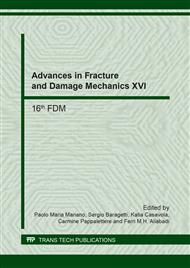p.3
p.7
p.11
p.15
p.19
p.23
p.27
p.31
SEM Study of Fatigue Crack Propagation in Chromium Martensitic Steel after LCF
Abstract:
Crack propagation after low-cycle fatigue (LCF) deformation has been studied in the chromium martensitic structural steel. Although the study of a fundamental mechanism of fatigue crack growth has received much attention over the last decade, it still remains a sufficiently complex problem and needs full understanding. Moreover, the recent studies show that the cracks propagate discontinuously even on the millisecond timescale, and their growth rate significantly depends on a microstructure of the material. In the present work the boundaries of the former austenitic grains were revealed on the polished surfaces of the thermally treated samples, which subsequently were undergone low-cycle fatigue tests. The experimental studies show that fatigue macrocracks mainly grow along the boundaries of the former austenitic grains, and changetheir propagation direction when crossing the grain boundary, however, remain within 45 ̊ interval with regard the cycling axis. In particular cases, when the boundaries of a martensite packets and those of the former austenite grains lay along the length of a packet, the macrocrack is better formed and with regular borders. After a macrocrack reaches a definite length ~30-50μ, a microcrack is nucleated ahead of the macrocrack tip, and is oriented along the substructure element of the steel. Further deformation tests provide an increase in the length of the main crack via aggregation of microcracks initiated ahead of it during the LCF. In the cases when the macrocrack is deviated, slip bands are formed in martensitic structures along the boundaries of martensite packets (laths). A correlation is revealed between the microcrack components and the substructure elements of the steel as well. The same results were obtained by fractography of the tested and fractured samples. However, in the latter case correlation was established between the cleavage facets and the dimensions of packets.
Info:
Periodical:
Pages:
15-18
Citation:
Online since:
September 2017
Authors:
Keywords:
Price:
Сopyright:
© 2017 Trans Tech Publications Ltd. All Rights Reserved
Share:
Citation:


